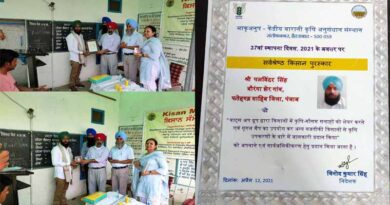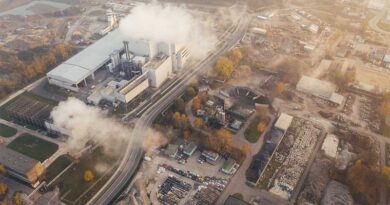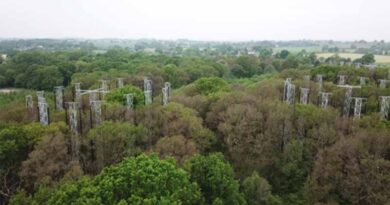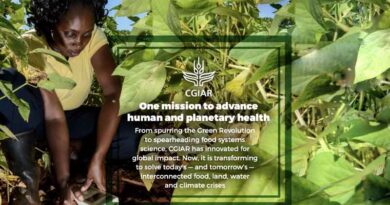Navigating the Intersection: Exploring the Relationship Between Climate Change and Agriculture
Guest Author: Mr. Tushar Trivedi, Head of Farm Business, nurture.farm
04 July 2023, New Delhi: To understand the relationship between climate change and agriculture, imagine this – In a small village in rural India, a farmer battles against the unforgiving elements of nature. The once fertile land that sustained generations of his family now faces unpredictable weather patterns, prolonged droughts, and devastating floods. He fights relentlessly to salvage his crops, but the odds seem insurmountable. Day by day, he witnesses the heartbreaking sight of his hard work and livelihood crumbling. The despair of this farmer is akin to that felt by many whose livelihoods depend on agriculture.
Climate change has adverse implications for farmers and the future of food production in our country – an industry upon which every individual depends. It’s a complex puzzle requiring innovative solutions and a deep understanding of the agricultural landscape and the latest technological advancements. Here are some effects of climate change on the Indian agrarian ecosystem and their consequences.
Erratic Monsoons
The Southwest monsoon accounts for 70% of India’s annual rainfall & is crucial for its agricultural economy, accounting for 11% of the gross domestic product of the country. Over the past 5 to 10 years, the rainfall continues to be erratic, and irregular, and report many instances of one of “rain events” that led to crop losses due to excessive flooding. Climate assessments at National & International levels have flagged these instances of erratic monsoons, and the IMD’s seasonal rainfall data over the past 120 years show a decrease in the rainfall.
As per the reports released by the Ministry of Earth Sciences, there is a 6% decline in the monsoon rainfall in the India region. As per the report, the variability & irregularities of monsoons are set to continue over the years. These irregularities in rain directly impact crop yields, water availability, and yield quality.
Indirectly the rain irregularities affect food security, inflation & more. With about 55% of arable land in India dependent on rain, farmers need help to cope with these changing rainfall patterns leading to losses, debts, and instances of moving away from agriculture cultivation altogether.
To mitigate these challenges, farmers need to be educated about risk cover solutions, guidance on the use of agri-inputs with water-retention properties, drought-resistant seed varieties, water management techniques like drip irrigation & drone-guided irrigation, offered weather-related advisory services, and accessibility to modern technologies that can help them manage these risks, and become more resilient.
Rising Temperatures
Climatologists are concerned & predict that this year or the coming year could be the hottest ever recorded in history and the likelihood of 2023 being an El Nino year. In El Nino years, temperatures could increase by 1 to 1.5 degrees Celsius, drastically impacting crop yield, yield quality, and an exponential increase in pests & disease attacks. High temperatures also lead to a drying out of the top layer of soil, making it prone to erosion.
Crops grown in Kharif, like Paddy (cultivated on more than 25 million hectares of land), are sensitive to temperature fluctuations. An increase in temperature during the critical growth stage may reduce yield by up to 10%.
To mitigate these changes & safeguard themselves against increasing temperatures, farmers can opt-in for various crop protection products that boost crop immunity against rising temperatures, opt-in for risk cover solutions to mitigate the risk of crop failure, and can adapt these techniques such as:
Drip-irrigation
Drip irrigation helps keep the crops cool, ensures soil moisture content is managed, and can help prevent crop losses. The main objective for Drip irrigation is less water and more production by improving fertilizer use efficiency.
Netting
Netting is a protective cloth layer that can come in handy against rough weather & extreme heat, especially for vegetable crops.
Mulching
Mulch material can be composted, manure, raked leaves, dried grass clippings, or any other organic material, such as bark. Mulch helps soil retain moisture and helps fix depleted nitrogen, creating cooler microenvironments at the base of the plant.
Water Scarcity
Changing precipitation patterns and reduced groundwater levels pose challenges for farmers relying on traditional irrigation methods. Agriculture is responsible for 70% of freshwater consumption in India. More than 60% of farmers rely on groundwater for cultivation, and as per the latest reports published by the Water Resource Group(WRG), by 2030, the groundwater will be 50% lower than needed in India.
Despite the availability of sprinklers & drip irrigation systems, the adoption & penetration of these modern innovations is 2.1% & 3.3% in India. Availability of inputs, technology, and modern equipment needs to be made accessible & affordable to the farmers at scale to help them combat climate change without compromising on yield.
Pests and Diseases
Changing climate conditions leading to heat waves, drought, and excessive rainfall impact plant physiology, crop health, and soil health, leading to increased instances of pest & disease attacks.
Almost 35% of crops are lost due to pest & disease attacks. Per estimates, every 1-degree increase in global temperatures will increase pest-linked yield losses by 10-25%.
Even though farmers know the availability of crop protection & crop nutrition products, they need more education around usage, spraying, cultivation practices, spraying windows, and help to choose the right products.
Average crop protection constitutes only 5%-8% of a farmer’s total production costs. Its adoption stands at 2% of global consumption and is confined to ¼ of the arable land totaling 180 million hectares.
Adoption of Integrated Pest Management frameworks can help farmers mitigate risks against pest and disease attacks. The Integrated Pest Management framework combines lessons learned from plant pathology and epidemiology, weed, insect science, and nematology. Integrated Pest Management frameworks acknowledge the importance of crop protection & crop nutrition solutions while focusing on monitoring and prevention of pests & disease attacks.
Lastly, farmers can educate themselves about various Crop Protection & Crop solution products available in the market, leverage mechanization, and opt-in for crop-specific advisory services to mitigate & minimize crop losses owing to pest & disease attacks.
The way forward: An amalgamation of the power of technology with sustainability
The future of Indian agriculture depends on those who embrace sustainable practices and harness the power of technology. By doing so, we can create a resilient and prosperous agricultural sector that not only tackles the challenges of climate change but also contributes to a sustainable and food-secure future for India. Here are a few ways the segment can triumph over the current obstacles.
Precision Farming
Leveraging modern equipment, technology, and mechanization tools from sowing to cultivation to harvest & post-harvest management can help boost farm productivity and efficiency and minimize waste. Mechanization tools like boom sprayers can help farmers spray about 1 acre of land in less than 10 mins, ensuring optimal input use and crop protection. Drones can do fly-bys to capture images of the farm and help pinpoint areas of disease infestations. By reducing tillage and adapting precision agriculture practices, soil organic carbon content can be bolstered, and carbon sequestered.
Technology and Innovation
Farm Digitization tools are helping create education and awareness amongst farmers about good agricultural practices and deliver weather & crop-related advisory on time.
Other technological innovations like IoT sensors, Geo-Spatial Imaging, and satellite data can be used by farmers to monitor soil health, moisture level, NAVI & NDVI, leaf surface areas, etc., to monitor crop health, predict acreage, and offer harvest date estimates, ensuring optimal use of inputs, effective pest management, resource efficiency, and deliver environmental impact.
Machine Learning & AI Models developed based on the soil, plant, environment, crop, and cultivation parameters can predict the occurrence of pests & disease up to 15 days in advance with an accuracy of 95% or more.
Technology & platforms together are helping with implementing and monitoring sustainable farming practices, delivering traceability of land records, and creating farmer/farm profiles that can be used to improve the accessibility of inputs, improving farmer resilience, and deliver market connectivity & capital to the farmers.
Policy Support
Technology interventions act as critical drivers to propel growth for agriculture. The government has already set up its “Digital Agriculture Mission” to transform Agriculture digitally. However, the government must draft additional initiatives and policies to encourage farmers to adopt sustainable farming practices.
Policy frameworks focused on prioritizing capacity building, farmer education, and kickstart initiatives that promote research & development on technologies/solutions that help mitigate climate change. To further drive the shift towards climate-smart & sustainable agriculture practices, the government can contemplate drafting policies offering tax benefits, grants, and subsidies to domestic companies focused on solving climate change to help India become an epicenter of global carbon trading.
Other initiatives can include a national-level securitization cum asset-backed security platform for infrastructure and green loans, providing tax benefits for income from the sale of Renewable Energy Certificates.
Community Participation
For change to be effective, it must be inclusive. We must collectively work together as a community to educate, train, and scale our efforts to bring about change. More public-private partnerships, the collaboration of resources, consolidation of data & knowledge repositories, and supportive policies are needed to build a network of enablers, advisors, and experts who work on a ground level. These enablers will help drive engagement, awareness, and education within the farmer community by solving their queries, offering advice, and ensuring that good agricultural practices are followed.
Bottomline
The most inclusive way to solve the planet’s problems, farmers, consumers, and growers alike, is by paving the way for adopting climate-smart & sustainable farming practices. We can achieve it by enabling smallholders with the know-how, making technology accessible and affordable, and offering incentives to the farmers to drive the change. Only then can we build an agri-ecosystem that’s viable, self-sufficient, and profitable.
Also Read: Bayer grant to explore the potential of native grains
(For Latest Agriculture News & Updates, follow Krishak Jagat on Google News)















